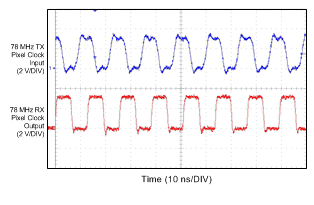-
DS90UB926Q-Q1 5- to 85-MHz, 24-Bit Color FPD-Link III Deserializer With Bidirectional Control Channel
- 1 Features
- 2 Applications
- 3 Description
- 4 Revision History
- 5 Description (continued)
- 6 Pin Configuration and Functions
-
7 Specifications
- 7.1 Absolute Maximum Ratings
- 7.2 ESD Ratings
- 7.3 Recommended Operating Conditions
- 7.4 Thermal Information
- 7.5 DC Electrical Characteristics
- 7.6 AC Electrical Characteristics
- 7.7 DC and AC Serial Control Bus Characteristics
- 7.8 Timing Requirements
- 7.9 Timing Requirements for the Serial Control Bus
- 7.10 Switching Characteristics
- 7.11 Timing Diagrams
- 7.12 Typical Characteristics
-
8 Detailed Description
- 8.1 Overview
- 8.2 Functional Block Diagram
- 8.3
Feature Description
- 8.3.1 High-Speed Forward Channel Data Transfer
- 8.3.2 Low-Speed Back Channel Data Transfer
- 8.3.3 Backward-Compatible Mode
- 8.3.4 Input Equalization Gain
- 8.3.5 Common-Mode Filter Pin (CMF)
- 8.3.6 Video Control Signal Filter
- 8.3.7 EMI Reduction Features
- 8.3.8 Enhanced Progressive Turnon (EPTO)
- 8.3.9 LVCMOS VDDIO Option
- 8.3.10 Power Down (PDB)
- 8.3.11 Stop Stream Sleep
- 8.3.12 Serial Link Fault Detect
- 8.3.13 Oscillator Output
- 8.3.14 Pixel Clock Edge Select (RFB)
- 8.3.15 Image Enhancement Features
- 8.3.16 Internal Pattern Generation
- 8.3.17 Built-In Self Test (BIST)
- 8.3.18 I2S Receiving
- 8.3.19 Interrupt Pin — Functional Description and Usage (INTB)
- 8.3.20 GPIO[3:0] and GPO_REG[8:4]
- 8.4 Device Functional Modes
- 8.5 Programming
- 8.6 Register Maps
- 9 Application and Implementation
- 10Power Supply Recommendations
- 11Layout
- 12Device and Documentation Support
- 13Mechanical, Packaging, and Orderable Information
- IMPORTANT NOTICE
Package Options
Mechanical Data (Package|Pins)
- NKB|60
Thermal pad, mechanical data (Package|Pins)
Orderable Information
DS90UB926Q-Q1 5- to 85-MHz, 24-Bit Color FPD-Link III Deserializer With Bidirectional Control Channel
1 Features
- AEC-Q100 Qualified for Automotive Applications
- Device Temperature Grade 2: –40°C to +105°C Ambient Operating Temperature
- Device HBM ESD Classification Level 3B
- Device CDM ESD Classification Level C6
- Device MM ESD Classification Level M3
- Bidirectional Control Interface Channel Interface With I2C-Compatible Serial Control Bus
- Supports High-Definition (720p) Digital Video Format
- RGB888 + VS, HS, DE and Synchronized I2S Audio Supported
- 5- to 85-MHz PCLK Supported
- Single 3.3-V Operation With 1.8-V or 3.3-V Compatible LVCMOS I/O Interface
- AC-Coupled STP Interconnect up to 10 Meters
- Parallel LVCMOS Video Outputs
- I2C-Compatible Serial Control Bus for Configuration
- DC-Balanced and Scrambled Data With Embedded Clock
- Adaptive Cable Equalization
- Supports Repeater Application
- @ SPEED Link BIST Mode and LOCK Status Pin
- Image Enhancement (White Balance and Dithering) and Internal Pattern Generation
- EMI Minimization (SSCG and EPTO)
- Low Power Modes Minimize Power Dissipation
- Backward-Compatible With FPD-Link II
2 Applications
- Automotive Display for Navigation
- Rear Seat Entertainment Systems
- Automotive Drive Assistance
- Automotive Megapixel Camera Systems
3 Description
The DS90UB926Q-Q1 deserializer, in conjunction with the DS90UB925Q-Q1 serializer, provides a complete digital interface for concurrent transmission of high-speed video, audio, and control data for automotive display and image-sensing applications.
This chipset translates a parallel RGB video interface into a single-pair high-speed serialized interface. The serial bus scheme, FPD-Link III, supports full duplex of high-speed forward data transmission and low-speed backchannel communication over a single differential link. Consolidation of video data and control over a single differential pair reduces the interconnect size and weight, while also eliminating skew issues and simplifying system design.
The DS90UB926Q-Q1 deserializer recovers the RGB data, three video control signals, and four synchronized I2S audio signals. The device extracts the clock from a high-speed serial stream. An output LOCK pin provides the link status if the incoming data stream is locked, without the use of a training sequence or special SYNC patterns, as well as a reference clock.
Device Information(1)
| PART NUMBER | PACKAGE | BODY SIZE (NOM) |
|---|---|---|
| DS90UB926Q-Q1 | WQFN (60) | 9.00 mm × 9.00 mm |
- For all available packages, see the orderable addendum at the end of the data sheet.
Typical Display System Diagram
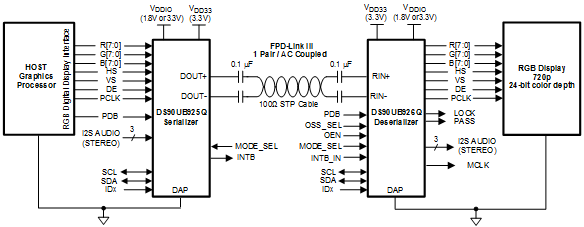
4 Revision History
Changes from C Revision (February 2017) to D Revision
- Reverted all previous MLCK content changes made in Revision C back to Revision BGo
- Deleted the disable I2S jitter cleaner noteGo
Changes from B Revision (January 2015) to C Revision
- Changed pin 60 from MCLK to RES2 Go
- Changed MCLK to RES2 Go
- Added note to disable I2S jitter cleaner Go
- Changed MCLK to RES2 Go
- Deleted reference to MCLK in this section Go
- Deleted reference to MCLK in this section Go
- Deleted reference to MCLKGo
- Changed MCLK section Go
- Changed MCLK columns of Audio Interface Frequencies table Go
- Changed the values in columns 2 through 5 in Configuration Select (MODE_SEL) tableGo
- Changed the values in columns 2 to 5 in Serial Control Bus Addresses for IDx tableGo
- Changed register reference to MCLK Go
- Changed Typical Display System Diagram (removed reference to MCLK) Go
- Changed wording of Power Up Requirements and PDB Pin subsection and added Power-Up Sequence graphicGo
Changes from A Revision (April 2013) to B Revision
- Added Pin Configuration and Functions section, ESD Ratings table, Feature Description section, Device Functional Modes, Application and Implementation section, Power Supply Recommendations section, Layout section, Device and Documentation Support section, and Mechanical, Packaging, and Orderable Information sectionGo
Changes from * Revision (July 2012) to A Revision
- Corrected typo in table “DC and AC Serial Control Bus Characteristics” from VDDIO to VDD33, added “Note: BIST is not available in backwards compatible mode.”, added Recommended FRC settings table, changed entire layout of Data Sheet to TI format, added to Absolute Maximum Rating section, note (3): The maximum limit (VDDIO +0.3V) does not apply to the PDB pin during the transition to the power down state (PDB transitioning from HIGH to LOW), deleted derate from Maximum Power Dissipation Capacity at 25°C.Go
- "Note: BIST is not available in backwards compatible mode."Go
5 Description (continued)
The DS90UB926Q-Q1 deserializer has a 31-bit parallel LVCMOS output interface to accommodate the RGB, video control, and audio data.
An adaptive equalizer optimizes the maximum cable reach. EMI is minimized by output SSC generation (SSCG) and enhanced progressive turnon (EPTO) features.
6 Pin Configuration and Functions
Pin Functions
| PIN | I/O, TYPE | DESCRIPTION | |
|---|---|---|---|
| NAME | NO. | ||
| LVCMOS PARALLEL INTERFACE | |||
| ROUT[23:0] / R[7:0], G[7:0], B[7:0] | 41, 40, 39, 37, 36, 35, 34, 33, 28, 27, 26, 25, 23, 22, 21, 20, 19, 18, 17, 14, 12, 11, 10, 9 | O, LVCMOS with pulldown |
Parallel Interface Data Output Pins Leave open if unused. ROUT0 / R0 can optionally be used as GPIO0 and ROUT1 / R1 can optionally be used as GPIO1. ROUT8 / G0 can optionally be used as GPIO2 and ROUT9 / G1 can optionally be used as GPIO3. ROUT16 / B0 can optionally be used as GPO_REG4 and ROUT17/ B1 can optionally be used as I2S_DB / GPO_REG5. |
| HS | 8 | O, LVCMOS with pulldown |
Horizontal Sync Output Pin Video control signal pulse width must be 3 PCLKs or longer to be transmitted when the Control Signal Filter is enabled. There is no restriction on the minimum transition pulse when the Control Signal Filter is disabled. The signal is limited to 2 transitions per 130 PCLKs. See Table 11 |
| VS | 7 | O, LVCMOS with pulldown |
Vertical Sync Output Pin Video control signal is limited to 1 transition per 130 PCLKs. Thus, the minimum pulse width is 130 PCLKs. |
| DE | 6 | O, LVCMOS with pulldown |
Data Enable Output Pin Video control signal pulse width must be 3 PCLKs or longer to be transmitted when the Control Signal Filter is enabled. There is no restriction on the minimum transition pulse when the Control Signal Filter is disabled. The signal is limited to 2 transitions per 130 PCLKs. See Table 11 |
| PCLK | 5 | O, LVCMOS with pulldown |
Pixel Clock Output Pin. Strobe edge set by RFB configuration register. See Table 11 |
| I2S_CLK, I2S_WC, I2S_DA | 1, 30, 45 | O, LVCMOS with pulldown |
Digital Audio Interface Data Output Pins Leave open if unused I2S_CLK can optionally be used as GPO_REG8, I2S_WC can optionally be used as GPO_REG7, and I2S_DA can optionally be used as GPO_REG6. |
| MCLK | 60 | O, LVCMOS with pulldown |
I2S Master Clock Output x1, x2, or x4 of I2S_CLK Frequency |
| OPTIONAL PARALLEL INTERFACE | |||
| I2S_DB | 18 | O, LVCMOS with pulldown |
Second Channel Digital Audio Interface Data Output pin at 18–bit color mode and set by MODE_SEL or configuration register Leave open if unused I2S_B can optionally be used as BI or GPO_REG5. |
| GPIO[3:0] | 27, 28, 40, 41 | I/O, LVCMOS with pulldown |
Standard General Purpose IOs. Available only in 18-bit color mode, and set by MODE_SEL or configuration register. See Table 11 Leave open if unused Shared with G1, G0, R1 and R0. |
| GPO_REG[8:4] | 1, 30, 45, 18, 19 | O, LVCMOS with pulldown |
General Purpose Outputs and set by configuration register. See Table 11
Shared with I2S_CLK, I2S_WC, I2S_DA, I2S_DB or B1, B0. |
| INTB_IN | 16 | Input, LVCMOS with pulldown | Interrupt Input Shared with BISTC |
| OPTIONAL PARALLEL INTERFACE | |||
| PDB | 59 | I, LVCMOS with pulldown |
Power-down Mode Input Pin PDB = H, device is enabled (normal operation) Refer to Power Up Requirements and PDB Pin. PDB = L, device is powered down. When the device is in the POWER DOWN state, the LVCMOS Outputs are in TRI-STATE, the PLL is shutdown and IDD is minimized. . |
| OEN | 31 | Input, LVCMOS with pulldown | Output Enable Pin See Table 8 |
| OSS_SEL | 46 | Input, LVCMOS with pulldown | Output Sleep State Select Pin See Table 8 |
| MODE_SEL | 15 | I, Analog | Device Configuration Select. See Table 9 |
| IDx | 56 | I, Analog | I2C Serial Control Bus Device ID Address Select External pullup to VDD33 is required under all conditions, DO NOT FLOAT. Connect to external pullup and pulldown resistor to create a voltage divider. See Figure 23 |
| SCL | 3 | I/O, LVCMOS Open-Drain |
I2C Clock Input / Output Interface Must have an external pullup to VDD33, DO NOT FLOAT. Recommended pullup: 4.7 kΩ. |
| SDA | 2 | I/O, LVCMOS Open-Drain |
I2C Data Input / Output Interface Must have an external pullup to VDD33, DO NOT FLOAT. Recommended pullup: 4.7 kΩ. |
| BISTEN | 44 | I, LVCMOS with pulldown | BIST Enable Pin 0: BIST Mode is disabled. 1: BIST Mode is enabled. |
| BISTC | 16 | I, LVCMOS with pulldown | BIST Clock Select Shared with INTB_IN 0: PCLK; 1: 33 MHz |
| STATUS | |||
| LOCK | 32 | O, LVCMOS with pulldown | LOCK Status Output Pin 0: PLL is unlocked, ROUT[23:0]/RGB[7:0], I2S[2:0], HS, VS, DE and PCLK output states are controlled by OEN. May be used as Link Status or Display Enable 1: PLL is Locked, outputs are active |
| PASS | 42 | O, LVCMOS with pulldown | PASS Output Pin 0: One or more errors were detected in the received payload 1: ERROR FREE Transmission Leave Open if unused. Route to test point (pad) recommended |
| FPD-LINK III SERIAL INTERFACE | |||
| RIN+ | 49 | I, LVDS | True Input. The interconnection should be AC-coupled to this pin with a 0.1-μF capacitor. |
| RIN- | 50 | I, LVDS | Inverting Input. The interconnection should be AC-coupled to this pin with a 0.1-μF capacitor. |
| CMLOUTP | 52 | O, LVDS | True CML Output Monitor point for equalized differential signal |
| CMLOUTN | 53 | O, LVDS | Inverting CML Output Monitor point for equalized differential signal |
| CMF | 51 | Analog | Common Mode Filter. Connect 0.1-μF capacitor to GND |
| POWER AND GROUND(1) | |||
| VDD33_A, VDD33_B | 48, 29 | Power | Power to on-chip regulator 3 V – 3.6 V. Requires 4.7 µF to GND at each VDD pin. |
| VDDIO | 13, 24, 38 | Power | LVCMOS I/O Power 1.8 V ±5% OR 3 V – 3.6 V. Requires 4.7 µF to GND at each VDDIO pin. |
| GND | DAP | Ground | DAP is the large metal contact at the bottom side, located at the center of the WQFN package. Connect to the ground plane (GND) with at least 9 vias. |
| REGULATOR CAPACITOR | |||
| CAPR12, CAPP12, CAPI2S | 55, 57, 58 | CAP | Decoupling capacitor connection for on-chip regulator. Requires a 4.7 µF to GND at each CAP pin. |
| CAPL12 | 4 | CAP | Decoupling capacitor connection for on-chip regulator. Requires two 4.7 µF to GND at this CAP pin. |
| OTHERS | |||
| NC | 54 | NC | No connect. This pin may be left open or tied to any level. |
| RES[1:0] | 43.47 | GND | Reserved - tie to Ground. |
7 Specifications
7.1 Absolute Maximum Ratings
See(1)(2)(3)(4)| MIN | MAX | UNIT | ||
|---|---|---|---|---|
| Supply voltage – VDD33 | −0.3 | 4 | V | |
| Supply voltage – VDDIO | −0.3 | 4 | V | |
| LVCMOS I/O voltage | −0.3 | (VDDIO + 0.3) | V | |
| Deserializer input voltage | −0.3 | 2.75 | V | |
| Junction temperature | 150 | °C | ||
| Maximum power dissipation capacity at 25°C | RθJA | 31 | °C/W | |
| RθJC | 2.4 | °C/W | ||
| Storage temperature, Tstg | −65 | 150 | °C | |
7.2 ESD Ratings
| VALUE | UNIT | ||||
|---|---|---|---|---|---|
| V(ESD) | Electrostatic discharge | Human-body model (HBM), per AEC Q100-002(1) | ±8000 | V | |
| Charged-device model (CDM), per AEC Q100-011 | ±1250 | ||||
| Machine model | ±250 | ||||
| (IEC, powered-up only) RD = 330 Ω, CS = 150 pF |
Air Discharge (Pin 49 and 50) | ±15000 | |||
| Contact Discharge (Pin 49 and 50) | ±8000 | ||||
| (ISO1060SN5), RD = 330 Ω CS = 150 pF |
Air Discharge (Pin 49 and 50) | ±15000 | |||
| Contact Discharge (Pin 49 and 50) | ±8000 | ||||
| (ISO10605), RD = 2 kΩ CS = 150 and 330 pF |
Air Discharge (Pin 49 and 50) | ±15000 | |||
| Contact Discharge (Pin 49 and 50) | ±8000 | ||||
7.3 Recommended Operating Conditions
| MIN | NOM | MAX | UNIT | ||
|---|---|---|---|---|---|
| Supply voltage (VDD33) | 3 | 3.3 | 3.6 | V | |
| LVCMOS supply voltage (VDDIO) | Connect VDDIO to 3.3 V and use 3.3-V IOs | 3 | 3.3 | 3.6 | V |
| Connect VDDIO to 1.8 V and use 1.8-V IOs | 1.71 | 1.8 | 1.89 | V | |
| Operating free air temperature (TA) | −40 | 25 | 105 | °C | |
| PCLK frequency | 5 | 85 | MHz | ||
| Supply noise(1) | 100 | mVP-P | |||
7.4 Thermal Information
| THERMAL METRIC(1) | DS90UB926Q-Q1 | UNIT | |
|---|---|---|---|
| NKB (WQFN) | |||
| 60 PINS | |||
| RθJA | Junction-to-ambient thermal resistance | 26.2 | °C/W |
| RθJC(top) | Junction-to-case (top) thermal resistance | 8.1 | °C/W |
| RθJB | Junction-to-board thermal resistance | 5.2 | °C/W |
| ψJT | Junction-to-top characterization parameter | 0.1 | °C/W |
| ψJB | Junction-to-board characterization parameter | 5.2 | °C/W |
| RθJC(bot) | Junction-to-case (bottom) thermal resistance | 1.1 | °C/W |
7.5 DC Electrical Characteristics
over recommended operating supply and temperature ranges unless otherwise specified.(1) (2) (3)| PARAMETER | TEST CONDITIONS | PIN/FREQ. | MIN | TYP | MAX | UNIT | ||
|---|---|---|---|---|---|---|---|---|
| LVCMOS I/O DC SPECIFICATIONS | ||||||||
| VIH | High Level Voltage | VDDIO = 3 to 3.6 V | PDB | 2 | VDDIO | V | ||
| VIL | Low Level Input | VDDIO = 3 to 3.6 V | GND | 0.8 | V | |||
| IIN | Input Current | VIN = 0 V or VDDIO = 3 to 3.6 V | –10 | ±1 | 10 | µA | ||
| VIH | High Level Input Voltage | VDDIO = 3 to 3.6 V | OEN, OSS_SEL, BISTEN, BISTC / INTB_IN, GPIO[3:0] | 2 | VDDIO | V | ||
| VDDIO = 1.71 to 1.89 V | 0.65 × VDDIO |
VDDIO | ||||||
| VIL | Low Level Input Voltage | VDDIO = 3 to 3.6 V | GND | 0.8 | V | |||
| VDDIO = 1.71 to 1.89 V | GND | 0.35 × VDDIO |
||||||
| IIN | Input Current | VIN = 0 V or VDDIO | VDDIO = 3 to 3.6 V |
−10 | ±1 | 10 | μA | |
| VDDIO = 1.7 to 1.89 V |
−10 | ±1 | 10 | |||||
| VOH | High Level Output Voltage | IOH = −4 mA | VDDIO = 3 to 3.6 V | ROUT[23:0], HS, VS, DE, PCLK, LOCK, PASS, MCLK, I2S_CLK, I2S_WC, I2S_DA, I2S_DB, GPO_REG[8:4] | 2.4 | VDDIO | V | |
| VDDIO = 1.7 to 1.89 V |
VDDIO – 0.45 | VDDIO | ||||||
| VOL | Low Level Output Voltage | IOL = 4 mA | VDDIO = 3 to 3.6 V | GND | 0.4 | V | ||
| VDDIO = 1.7 to 1.89 V |
GND | 0.35 | ||||||
| IOS | Output Short Circuit Current | VOUT = 0 V | −60 | mA | ||||
| IOZ | Tri-state Output Current | VOUT = 0 V or VDDIO, PDB = L | −10 | 10 | μA | |||
| FPD-LINK III CML RECEIVER INPUT DC SPECIFICATIONS | ||||||||
| VTH | Differential Threshold High Voltage | VCM = 2.5 V (Internal VBIAS) |
RIN+, RIN– | 50 | mV | |||
| VTL | Differential Threshold Low Voltage | −50 | mV | |||||
| VCM | Differential Common-mode Voltage | 1.8 | V | |||||
| RT | Internal Termination Resistor - Differential | 80 | 100 | 120 | Ω | |||
| CML MONITOR DRIVER OUTPUT DC SPECIFICATIONS | ||||||||
| VODp-p | Differential Output Voltage | RL = 100 Ω | CMLOUTP, CMLOUTN | 360 | mVp-p | |||
| SUPPLY CURRENT | ||||||||
| IDD1 | Supply Current (includes load current) f = 85 MHz |
CL = 12 pF, Checker Board Pattern (Figure 1) |
VDD33= 3.6 V | VDD33 | 125 | 145 | mA | |
| IDDIO1 | VDDIO= 3.6 V | VDDIO | 110 | 118 | mA | |||
| VDDIO = 1.89 V | 60 | 75 | ||||||
| IDD2 | Supply Current (includes load current) f = 85MHz |
CL = 4 pF Checker Board Pattern (Figure 1) |
VDD33 = 3.6 V | VDD33 | 125 | 145 | mA | |
| IDDIO2 | VDDIO = 3.6 V | VDDIO | 75 | 85 | mA | |||
| VDDIO = 1.89 V | 50 | 65 | ||||||
| IDDS | Supply Current Sleep Mode | Without Input Serial Stream | VDD33 = 3.6 V | VDD33 | 90 | 115 | mA | |
| IDDIOS | VDDIO = 3.6 V | VDDIO | 3 | 5 | mA | |||
| VDDIO = 1.89 V | 2 | 3 | ||||||
| IDDZ | Supply Current Power Down | PDB = L, All LVCMOS inputs are floating or tied to GND | VDD33 = 3.6 V | VDD33 | 2 | 10 | mA | |
| IDDIOZ | VDDIO = 3.6 V | VDDIO | 0.05 | 10 | mA | |||
| VDDIO = 1.89 V | 0.05 | 10 | ||||||
7.6 AC Electrical Characteristics
Over recommended operating supply and temperature ranges unless otherwise specified.(1) (2) (3)| PARAMETER | TEST CONDITIONS | PIN/FREQ. | MIN | TYP | MAX | UNIT | |
|---|---|---|---|---|---|---|---|
| GPIO BIT RATE | |||||||
| BR | Forward Channel Bit Rate | See(5)(6) | f = 5 to 85 MHz, GPIO[3:0] |
0.25 × f | Mbps | ||
| Back Channel Bit Rate | >50 | >75 | kbps | ||||
| CML MONITOR DRIVER OUTPUT AC SPECIFICATIONS | |||||||
| EW | Differential Output Eye Opening Width(4) | RL = 100 Ω, Jitter Freq > f / 40 (Figure 2)(5)(6) |
CMLOUTP, CMLOUTN, f = 85 MHz |
0.3 | 0.4 | UI | |
| EH | Differential Output Eye Height | 200 | 300 | mV | |||
| BIST MODE | |||||||
| tPASS | BIST PASS Valid Time BISTEN = H (Figure 8)(5)(6) |
PASS | 800 | ns | |||
| SSCG MODE | |||||||
| fDEV | Spread Spectrum Clocking Deviation Frequency | See Figure 14, Table 1, Table 2 (5) (6) | f = 85 MHz, SSCG = ON |
±0.5% | ±2.5% | ||
| fMOD | Spread Spectrum Clocking Modulation Frequency | 8 | 100 | kHz | |||
7.7 DC and AC Serial Control Bus Characteristics
Over 3.3-V supply and temperature ranges unless otherwise specified.(1) (2) (3)| PARAMETER | TEST CONDITIONS | MIN | TYP | MAX | UNIT | |
|---|---|---|---|---|---|---|
| VIH | Input High Level | SDA and SCL | 0.7 × VDD33 |
VDD33 | V | |
| VIL | Input Low Level Voltage | SDA and SCL | GND | 0.3 × VDD33 |
V | |
| VHY | Input Hysteresis | > 50 | mV | |||
| VOL | SDA, IOL = 1.25 mA | 0 | 0.36 | V | ||
| Iin | SDA or SCL, VIN = VDD33 or GND | –10 | 10 | µA | ||
| tR | SDA RiseTime – READ | SDA, RPU = 10 kΩ, Cb ≤ 400 pF (Figure 9) | 430 | ns | ||
| tF | SDA Fall Time – READ | 20 | ns | |||
| tSU;DAT | Setup Time — READ | See Figure 9 | 560 | ns | ||
| tHD;DAT | Holdup Time — READ | See Figure 9 | 615 | ns | ||
| tSP | Input Filter | 50 | ns | |||
| Cin | Input Capacitance | SDA or SCL | < 5 | pF | ||
7.8 Timing Requirements
| MIN | NOM | MAX | UNIT | |||
|---|---|---|---|---|---|---|
| tR | SDA RiseTime – READ | SDA, RPU = 10 kΩ, Cb ≤ 400 pF (Figure 9) | 430 | ns | ||
| tF | SDA Fall Time – READ | 20 | ns | |||
| tSU;DAT | Setup Time — READ | See Figure 9 | 560 | ns | ||
| tHD;DAT | Holdup Time — READ | See Figure 9 | 615 | ns | ||
| tSP | Input Filter | 50 | ns | |||
7.9 Timing Requirements for the Serial Control Bus
Over 3.3-V supply and temperature ranges unless otherwise specified.| MIN | NOM | MAX | UNIT | |||
|---|---|---|---|---|---|---|
| fSCL | SCL Clock Frequency | Standard Mode | 0 | 100 | kHz | |
| Fast Mode | 0 | 400 | kHz | |||
| tLOW | SCL Low Period | Standard Mode | 4.7 | µs | ||
| Fast Mode | 1.3 | µs | ||||
| tHIGH | SCL High Period | Standard Mode | 4 | µs | ||
| Fast Mode | 0.6 | µs | ||||
| tHD;STA | Hold time for a start or a repeated start condition (Figure 9) | Standard Mode | 4 | µs | ||
| Fast Mode | 0.6 | µs | ||||
| tSU:STA | Setup time for a start or a repeated start condition (Figure 9) | Standard Mode | 4.7 | µs | ||
| Fast Mode | 0.6 | µs | ||||
| tHD;DAT | Data Hold Time (Figure 9) | Standard Mode | 0 | 3.45 | µs | |
| Fast Mode | 0 | 0.9 | µs | |||
| tSU;DAT | Data Setup Time (Figure 9) | Standard Mode | 250 | ns | ||
| Fast Mode | 100 | ns | ||||
| tSU;STO | Setup Time for STOP Condition (Figure 9) | Standard Mode | 4 | µs | ||
| Fast Mode | 0.6 | µs | ||||
| tBUF | Bus Free Time between STOP and START (Figure 9) | Standard Mode | 4.7 | µs | ||
| Fast Mode | 1.3 | µs | ||||
| tr | SCL and SDA Rise Time (Figure 9) | Standard Mode | 1000 | ns | ||
| Fast Mode | 300 | ns | ||||
| tf | SCL and SDA Fall Time (Figure 9) | Standard Mode | 300 | ns | ||
| Fast mode | 300 | ns |
7.10 Switching Characteristics
over operating free-air temperature range (unless otherwise noted)| PARAMETER | TEST CONDITIONS | PIN/FREQ. | MIN | TYP | MAX | UNIT | |
|---|---|---|---|---|---|---|---|
| tRCP | PCLK Output Period | tRCP = tTCP | PCLK | 11.76 | T | 200 | ns |
| tRDC | PCLK Output Duty Cycle | 45% | 50% | 55% | |||
| tCLH | LVCMOS Low-to-High Transition Time (Figure 3) | VDDIO = 1.71 to 1.89 V, CL = 12 pF |
ROUT[23:0], HS, VS, DE, PCLK, LOCK, PASS, MCLK, I2S_CLK, I2S_WC, I2S_DA, I2S_DB | 2 | 3 | ns | |
| VDDIO = 3 to 3.6 V, CL = 12 pF |
2 | 3 | ns | ||||
| tCHL | LVCMOS High-to-Low Transition Time (Figure 3) | VDDIO = 1.71 to 1.89 V, CL = 12 pF |
2 | 3 | ns | ||
| VDDIO = 3 to 3.6 V, CL = 12 pF |
2 | 3 | ns | ||||
| tROS | Data Valid before PCLK – Setup Time SSCG = OFF (Figure 6) |
VDDIO = 1.71 to 1.89 V, CL = 12 pF |
2.2 | ns | |||
| VDDIO = 3 to 3.6 V, CL = 12 pF |
2.2 | ns | |||||
| tROH | Data Valid after PCLK – Hold Time SSCG = OFF (Figure 6) |
VDDIO = 1.71 to 1.89 V, CL = 12 pF |
3 | ns | |||
| VDDIO = 3 to 3.6 V, CL = 12 pF |
3 | ns | |||||
| tXZR | Active to OFF Delay (Figure 5)(1) (2) | OEN = L, OSS_SEL = H | ROUT[23:0] | 10 | ns | ||
| HS, VS, DE, PCLK, LOCK, PASS | 15 | ns | |||||
| MCLK, I2S_CLK, I2S_WC, I2S_DA, I2S_DB | 60 | ns | |||||
| tDDLT | Lock Time (Figure 5)(1)(2)(3) | SSCG = OFF | f = 5 to 85MHz | 5 | 40 | ns | |
| tDD | Delay – Latency(1)(2) | f = 5 to 85MHz | 147*T | ns | |||
| tDCCJ | Cycle-to-Cycle Jitter(1)(2) | SSCG = OFF | f = 5 to <15 MHz | 0.5 | ns | ||
| f = 15 to 85 MHz | 0.2 | ns | |||||
| I2S_CLK = 1 to 12.28MHz | ±2 | ns | |||||
| tONS | Data Valid After OEN = H SetupTime (Figure 7)(1)(2) | VDDIO = 1.71 to 1.89 V, CL = 12 pF |
ROUT[23:0], HS, VS, DE, PCLK, MCLK, I2S_CLK, I2S_WC, I2S_DA, I2S_DB | 50 | ns | ||
| VDDIO = 3 to 3.6 V, CL = 12 pF |
50 | ns | |||||
| tONH | Data Tri-State After OEN = L SetupTime (Figure 7)(1)(2) | VDDIO = 1.71 to 1.89 V, CL = 12 pF |
50 | ns | |||
| VDDIO = 3 to 3.6 V, CL = 12 pF |
50 | ns | |||||
| tSES | Data Tri-State after OSS_ SEL = H, Setup Time (Figure 7)(1)(2) | VDDIO = 1.71 to 1.89 V, CL = 12 pF |
5 | ns | |||
| VDDIO = 3 to 3.6 V, CL = 12 pF |
5 | ns | |||||
| tSEH | Data to Low after OSS_SEL = L Setup Time (Figure 7)(1)(2) | VDDIO = 1.71 to 1.89 V, CL = 12 pF |
5 | ns | |||
| VDDIO = 3 to 3.6 V, CL = 12 pF |
5 | ns | |||||
7.11 Timing Diagrams
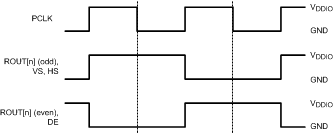 Figure 1. Checker Board Data Pattern
Figure 1. Checker Board Data Pattern
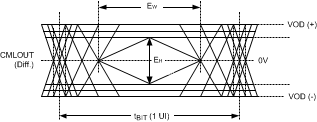 Figure 2. CML Output Driver
Figure 2. CML Output Driver
 Figure 3. LVCMOS Transition Times
Figure 3. LVCMOS Transition Times
 Figure 4. Delay - Latency
Figure 4. Delay - Latency
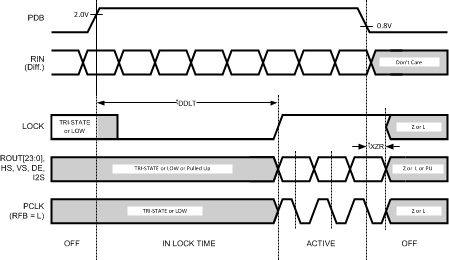 Figure 5. PLL Lock Times and PDB Tri-State Delay
Figure 5. PLL Lock Times and PDB Tri-State Delay
 Figure 6. Output Data Valid (Setup and Hold) Times With SSCG = Off
Figure 6. Output Data Valid (Setup and Hold) Times With SSCG = Off
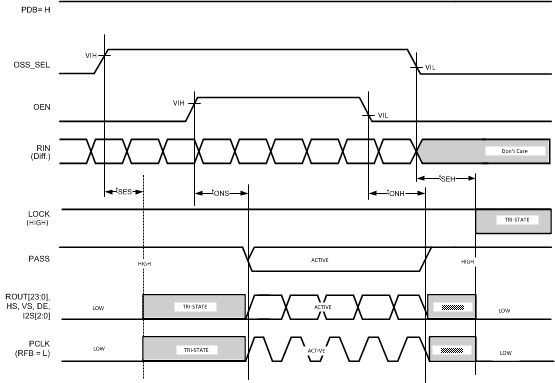 Figure 7. Output State (Setup and Hold) Times
Figure 7. Output State (Setup and Hold) Times
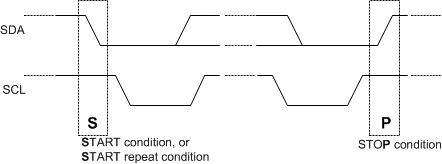 Figure 8. BIST PASS Waveform
Figure 8. BIST PASS Waveform
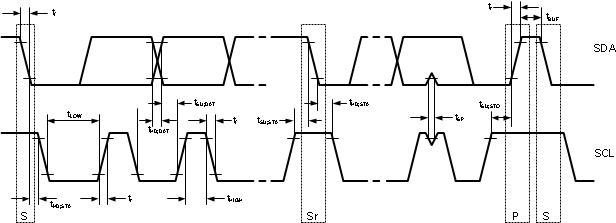 Figure 9. Serial Control Bus Timing Diagram
Figure 9. Serial Control Bus Timing Diagram
7.12 Typical Characteristics
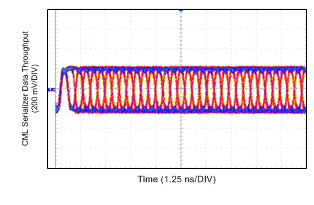
| Note: On the rising edge of each clock period, the CML driver outputs a low Stop bit, high Start bit, and 33 DC-scrambled data bits. | ||
With 78-MHZ TX Pixel Clock
